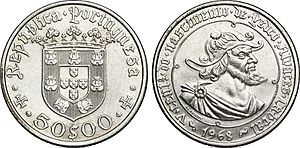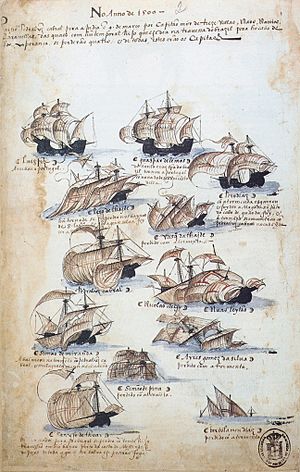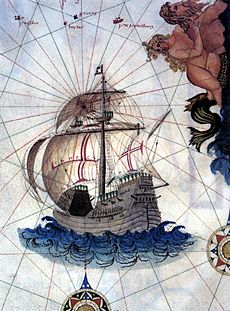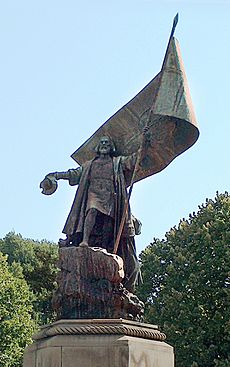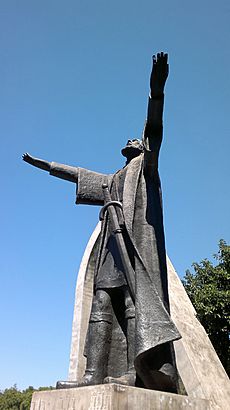Pedro Álvares Cabral facts for kids
Quick facts for kids
Pedro Álvares Cabral
|
|
|---|---|

A painting of Pedro Álvares Cabral. No pictures of him from his own time are known to exist.
|
|
| Born |
Pedro Álvares de Gouveia
1467 or 1468 Belmonte, Portugal
|
| Died | 1520 (aged 52–53) Santarém, Portugal
|
| Other names |
|
| Occupation | Fleet commander for Portugal |
| Spouse(s) | Isabel de Castro |
| Children |
|
| Signature | |
 |
|
Pedro Álvares Cabral (born around 1467 or 1468 – died around 1520) was a Portuguese nobleman and explorer. He is known as the European discoverer of Brazil. His famous voyage in 1500 was the first in history to connect four continents: Europe, Africa, America, and Asia.
Cabral led a fleet of 13 ships to India in 1500. His goal was to bring back valuable spices. He also wanted to set up trade with India. On his journey, his fleet sailed far into the western Atlantic Ocean. They landed on what he first thought was a large island. This new land was within Portugal's area, according to the Treaty of Tordesillas. So, Cabral claimed it for the Portuguese King. He explored the coast and realized it was probably a huge continent. He sent a ship back to tell King Manuel I about the new land. This continent was South America, and the land he claimed became known as Brazil.
After leaving Brazil, the fleet continued its journey to India. A big storm in the southern Atlantic caused several ships to sink. The remaining six ships met up again near Mozambique. They then sailed to Calicut in India. Cabral successfully made trade agreements there. But Arab merchants saw Portugal's trade as a threat. They caused an attack on the Portuguese trading post. Many Portuguese were killed. Cabral got revenge by burning the Arab fleet and bombing the city.
From Calicut, the expedition went to the Kingdom of Cochin. Cabral became friends with its ruler. He loaded his ships with spices before returning to Europe. Even with the loss of ships and men, Cabral's trip was a success. The huge profits from the spices helped Portugal's finances. This helped start the Portuguese Empire. This empire would stretch from the Americas to the Far East.
Later, Cabral was not chosen to lead a new fleet to India. This might have been because of a disagreement with King Manuel I. He then lived a quiet life. For over 300 years, his achievements were mostly forgotten. But after Brazil became independent in the 1800s, his importance was recognized. Historians still discuss if his discovery of Brazil was planned or by accident. Most agree that his voyage was very important. He is seen as a major figure of the Age of Discovery.
Contents
Early Life and Family
We don't know much about Pedro Álvares Cabral's early life. He was born in 1467 or 1468 in Belmonte. He was one of eleven children. His father was Fernão Álvares Cabral. His mother was Isabel Gouveia. Pedro was first named Pedro Álvares de Gouveia. He later started using his father's last name, Cabral. This happened after his older brother died in 1503.
His family's coat of arms had two purple goats on a silver background. Purple meant loyalty. The goats came from the family name. "Cabral" means "goats" in Portuguese. Only his older brother was allowed to use the family coat of arms.
The Cabral family became important in the 1300s. Cabral's great-great-grandfather, Álvaro Gil Cabral, was a military leader. He stayed loyal to King João I during a war. As a reward, the King gave him the land of Belmonte.
Cabral grew up as a member of the lower nobility. At about age 12, he went to the court of King Afonso V. He studied subjects like history and literature. He also learned how to use weapons and fight. In 1484, King João II gave him the title of moço fidalgo (young nobleman).
We don't have many records of what he did before 1500. He might have fought in North Africa, like other young nobles. In 1497, King Manuel I gave him money each year. He also made him a nobleman in the King's Council. He became a Knight of the Order of Christ.
There are no pictures or detailed descriptions of Cabral from his time. We know he was strongly built. He was as tall as his father, about 1.90 meters (6 feet 3 inches). People described Cabral as smart, polite, careful, and generous. He was also humble, but sometimes a bit proud.
Discovery of Brazil
Leading the Fleet
On February 15, 1500, Cabral was chosen to lead a fleet to India. He was called Capitão-mor, which means commander-in-chief. At that time, the Portuguese King often chose nobles to lead ships. They were chosen even if they had little experience. This was true for many of the captains under Cabral.
We don't know exactly why Cabral was chosen. The King's order only said "merits and services." Historians think King Manuel I knew him well. Also, the Cabral family was loyal to the King. Cabral's good looks and skills at court might have helped. His two brothers were also on the King's Council.
Cabral was the military leader. But more experienced sailors helped him with naval matters. These included Bartolomeu Dias, Diogo Dias, and Nicolau Coelho. They commanded 13 ships and 1,500 men. About 700 of these men were soldiers. Most of them were common people with no combat training.
The fleet had two parts. Nine large ships and two smaller ones went to Calicut, India. Their goal was to set up trade. Two other ships went to Sofala, in what is now Mozambique. Cabral was paid well for leading the fleet. He could also buy spices cheaply and sell them for a large profit. Spices were very rare and valuable in Europe.
Another fleet had already reached India by sailing around Africa. That trip was led by Vasco da Gama in 1499. For many years, Portugal wanted a new route to the East. They wanted to avoid the Mediterranean Sea, which was controlled by others. Portugal also wanted to spread Christianity. They also wanted to find the mythical Prester John. He was a powerful Christian king they hoped to ally with against Muslims. Finally, Portugal wanted a share of the rich trade in slaves, gold, and spices.
Journey and Landing in a New Land
Cabral's fleet left Lisbon on March 9, 1500. Cabral was 32 or 33 years old. The day before, there was a big send-off with a Mass and celebrations. The King and many people attended. On March 14, the fleet passed the Canary Islands. They reached Cape Verde on March 22. The next day, one ship with 150 men disappeared.
The fleet crossed the Equator on April 9. They sailed west, away from Africa. This was a known sailing method called volta do mar. On April 21, they saw seaweed. This meant land was near. They were right. The next afternoon, April 22, 1500, the fleet anchored. Cabral named the spot Monte Pascoal ("Easter Mount"). It was Easter week. This place is on the northeast coast of modern-day Brazil.
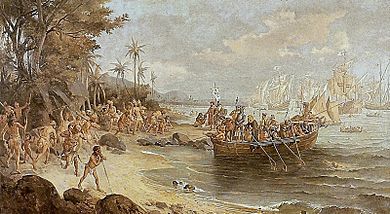
The Portuguese saw people on the shore. On April 23, all the ship captains met on Cabral's ship. Cabral sent Captain Nicolau Coelho ashore to meet them. Coelho had been on Vasco da Gama's trip. He went to land and traded gifts with the native people.
After Coelho returned, Cabral moved the fleet north. After sailing about 65 kilometers (40 miles), they anchored on April 24. Cabral named this place Porto Seguro (Safe Port). It was a good natural harbor. Two natives were brought aboard Cabral's ship.
The meeting was friendly. Cabral gave gifts to the locals. These people were Stone Age hunter-gatherers. Europeans called them "Indians". The men hunted and fished for food. The women did some small farming. They lived in many different tribes. The tribe Cabral met was the Tupiniquim. Some tribes moved around, others stayed in one place. They knew how to use fire but not metal.
On April 26, more friendly natives appeared. Cabral ordered his men to build an altar. A Christian Mass was held there. This was the first Mass in what would become Brazil. Cabral and his crew took part.
The next days were spent gathering water, food, and wood. The Portuguese also built a large wooden cross, about 7 meters (23 feet) long. Cabral figured out that this new land was east of the line between Portugal and Spain. This line was set by the Treaty of Tordesillas. So, the land belonged to Portugal. To make Portugal's claim official, the cross was put up. A second religious service was held on May 1. Cabral named the new land Ilha de Vera Cruz (Island of the True Cross) in honor of the cross. The next day, a supply ship was sent back to Portugal. It carried news of the discovery to the King.
Voyage to India
Disasters and New Friends
The fleet continued its journey on May 2 or 3, 1500. They sailed along the east coast of South America. Cabral became sure he had found a whole continent, not just an island. Around May 5, the fleet turned east towards Africa.
On May 23 or 24, they faced a terrible storm in the South Atlantic. Four ships were lost. About 380 men died. One of the lost ships was commanded by Bartolomeu Dias. He was the first European to reach the Cape of Good Hope in 1488.
The remaining ships were damaged and separated. One ship, led by Diogo Dias, sailed off alone. The other six ships managed to regroup. Cabral's group sailed east, past the Cape of Good Hope. They reached land in the Primeiras and Segundas Archipelago, off East Africa. The main fleet stayed near Sofala for ten days to make repairs. Then they went north. On May 26, they reached Kilwa Kisiwani. Cabral tried to make a treaty with the king there, but it didn't work.
From Kilwa Kisiwani, the fleet went to Malindi. They arrived on August 2. Cabral met the king there. They became friends and exchanged gifts. Pilots were hired in Malindi for the last part of the trip to India. The fleet set sail. They reached Anjadip, an island where ships often stopped for supplies. Here, the ships were repaired and painted. They made final plans to meet the ruler of Calicut.
Trouble in Calicut
The fleet left Anjadip and arrived in Calicut on September 13. Cabral successfully talked with the Zamorin (the ruler of Calicut). He got permission to set up a trading post and a warehouse. Cabral even helped the Zamorin with some military tasks to improve relations.
However, on December 16 or 17, the trading post was attacked by surprise. About 300 to several thousand Muslim Arabs and Hindu Indians attacked. More than 50 Portuguese were killed. The remaining defenders escaped to the ships. Some had to swim. Cabral thought jealous Arab merchants caused the attack. He waited 24 hours for an explanation from the ruler of Calicut. But no apology came.
The Portuguese were very angry. They seized ten Arab merchant ships in the harbor. About 600 of their crews were killed. Their goods were taken, and the ships were burned. Cabral also ordered his ships to bomb Calicut for a whole day. This was revenge for breaking the agreement.
The attack was partly due to Portuguese dislike of Muslims. This feeling had grown over centuries of fighting. Also, the Portuguese wanted to control the spice trade. They didn't want any competition. The Arabs also wanted to keep their control over spices. The Portuguese had demanded special treatment in trade. The letter from King Manuel I, brought by Cabral, asked for Arab traders to be excluded. The Muslim merchants feared losing their trade and jobs. They tried to turn the Hindu ruler against the Portuguese. Both sides were very suspicious of each other.
Historians say the Portuguese knew they were few in number. They wanted to punish this attack severely. They hoped this would make others fear and respect them in the future. Their powerful cannons helped them do this. This event set a pattern for how European powers would deal with Asia later on.
Journey Back to Europe
Vasco da Gama's trip reports had warned King Manuel I about another port south of Calicut. Cabral could trade there too. This city was Cochin. The fleet sailed there, arriving on December 24. Cochin was under Calicut's rule. But it wanted to be independent. The Portuguese used this to their advantage. This helped Portugal gain power in the region. Cabral made an alliance with Cochin's ruler. He also allied with rulers of other Indian cities. He was able to set up a trading post.
Finally, loaded with valuable spices, the fleet went to Kannur for more trade. They began their return journey to Portugal on January 16, 1501.
The expedition headed for the east coast of Africa. One ship got stuck on a sandbar and began to sink. There was no room for its cargo on other ships. So, the cargo was lost, and Cabral ordered the ship to be burned. The fleet then went to the Island of Mozambique. They took on supplies there. They also prepared the ships for the rough trip around the Cape of Good Hope. One small ship was sent to Sofala, another goal of the trip.
A second small ship, the fastest in the fleet, was sent ahead. It was captained by Nicolau Coelho. It was to tell the King about the trip's success. A third ship, commanded by Pedro de Ataíde, got separated after leaving Mozambique.
On May 22, the fleet, now only two ships, sailed around the Cape of Good Hope. They arrived in Beseguiche (near Dakar, Cape Verde) on June 2. There, they found Nicolau Coelho's ship. They also found the ship captained by Diogo Dias. This ship had been lost for over a year after the storm. Dias's ship had many adventures. It was in bad shape, with only seven sick and weak men left. One man was so happy to see his friends that he died.
Another Portuguese fleet was also in Beseguiche. After King Manuel I heard about the discovery of Brazil, he sent this smaller fleet to explore it. One of its navigators was Amerigo Vespucci. He told Cabral about his explorations. This confirmed that Cabral had indeed found a whole continent, not just an island.
Nicolau Coelho's ship left Beseguiche first. It arrived in Portugal on June 23, 1501. Cabral stayed behind, waiting for the missing ships. Both eventually appeared. Cabral arrived in Portugal on July 21, 1501. The other ships came home in the following days.
In total, two ships returned empty. Five were fully loaded. Six ships were lost. Still, the goods carried by the fleet brought huge profits to Portugal. The money earned covered all the costs of the trip. It even covered the cost of the lost ships. The profit was more than the total cost. Historians say Cabral's voyage was very well done. It helped start the Portuguese Empire across the world. It also led to Portugal's land empire in Brazil.
Later Life and Death
When Cabral returned, King Manuel I planned another fleet to India. This fleet was called the "Revenge Fleet." Cabral was chosen to command it. He prepared for eight months. But for unknown reasons, he was removed from command. It seems he disagreed about another navigator, Vicente Sodré, having independent command. Cabral strongly opposed this.
So, when the fleet left in March 1502, Vasco da Gama was the commander, not Cabral. There was a rivalry between those who supported da Gama and those who supported Cabral. Cabral eventually left the King's court for good. The King was very annoyed by this feud.
Even though he lost the King's favor, Cabral married well in 1503. He married Dona Isabel de Castro. She was a rich noblewoman. Her mother was the sister of Afonso de Albuquerque, a great Portuguese military leader. Cabral and Isabel had at least four children. Some sources say they had two more daughters.
Cabral suffered from fevers and tremors, possibly from malaria, after his voyage. He moved to Santarém in 1509. He spent his last years there. We have little information about what he did during that time. In 1509, he was involved in a property dispute. He also received special benefits for some military service. Around 1518, he was made a knight in the King's Council. He also received a monthly payment. This was in addition to the yearly payment he got since 1497.
Cabral most likely died in 1520. He was buried in the São João Evangelista chapel. This chapel is in the Convento da Graça in Santarém.
Legacy
Remembering Cabral
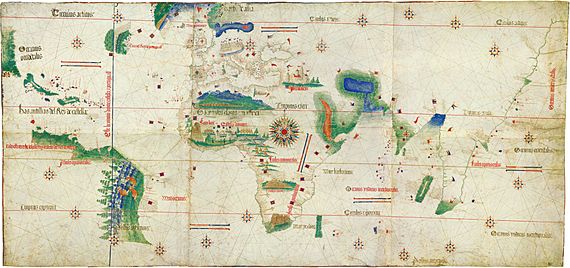
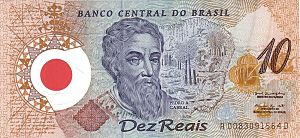
The first lasting Portuguese settlement in Brazil was in 1532. It was called São Vicente. Over the years, the Portuguese expanded their land in Brazil. By 1750, Brazil had most of its current borders. Portugal saw Brazil as the most important part of its empire. In 1822, Brazil became independent from Portugal. The Portuguese King's son, Dom Pedro I, became Brazil's first Emperor.
Cabral's discovery and even his burial place were almost forgotten for nearly 300 years. This changed in the 1840s. Emperor Dom Pedro II of Brazil supported research about Cabral. This was part of the Emperor's plan to make Brazilians feel more national pride. He wanted them to have a shared history.
In 1839, Cabral's burial place was found again by a Brazilian historian. The tomb was in poor condition. This almost caused a problem between Brazil and Portugal. In 1871, Emperor Pedro II visited Cabral's grave. He suggested digging up the remains for study. This happened in 1882. In 1896, an urn with earth and bone fragments was taken. This urn was brought to the old Cathedral of Rio de Janeiro in Brazil in 1903. Since then, Cabral has become a national hero in Brazil.
In Portugal, however, he is less famous than Vasco da Gama. Historians agree that Cabral's exploration was very important. It influenced history and trade. Some say few voyages have been more important for the future. But few were less appreciated at the time. Still, historians say Cabral's place in Portuguese history is very strong. He will always be remembered as the main discoverer of Brazil.
Was the Discovery Planned?
For over a century, scholars have argued if Cabral's discovery was by chance or planned. If it was planned, it means the Portuguese knew there was land to the west. Emperor Pedro II first brought up this question in 1854.
Before 1854, most people thought the discovery was an accident. Early books on the topic supported this idea. But in 1854, a book was published that said it was intentional. Since then, some scholars have agreed with this view.
However, many historians say there is no definite proof it was planned. They say there were signs or suspicions of land in the South Atlantic. But there is no clear evidence. The debate about whether it was planned or not is still ongoing. It will probably never be fully settled.
Other Explorers
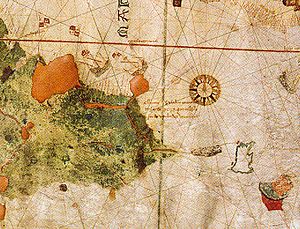
Cabral was not the first European to see parts of present-day Brazil. Other explorers had been to South America before. Norsemen reached North America and even settled there. But these settlements failed before the late 1400s. Christopher Columbus sailed along part of what is now Venezuela in 1498.
Some once thought that Portuguese navigator Duarte Pacheco Pereira visited the Brazilian coast in 1498. But this idea has been dismissed. Now, it's thought he went to North America instead.
There is stronger evidence that two Spaniards, Vicente Yáñez Pinzón and Diego de Lepe, sailed along Brazil's northern coast. This happened between January and March 1500. Pinzón went from what is now Cabo de Santo Agostinho to the mouth of the Amazon River. He met another Spanish group led by Lepe. Lepe's group reached the Oyapock River in March.
Cabral is given credit for discovering Brazil because the Spanish visits were short. They had no lasting impact. Historians agree that the Spanish trips did not affect the development of Brazil. Brazil became the only Portuguese-speaking nation in the Americas. It has a unique history and culture.
Titles and Honors
Nobility
- Moço fidalgo (young nobleman) on June 30, 1484.
- Fidalgo in the King's Council (nobleman in the King's Council) in 1497.
- Knight in the King's Council around 1518.
Honors
- Knight of the Portuguese Order of Christ in 1497.
See also
 In Spanish: Pedro Álvares Cabral para niños
In Spanish: Pedro Álvares Cabral para niños



